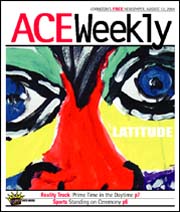Latitude, like any studio downtown, is busy with artists working towards upcoming projects. They are currently presenting a studio showcase at ArtsPlace, that opened last week, and will continue until September 2nd.
Bruce Burris of Latitude was invited by Jim Clark, president of LACC to put together the show—a typical request of any arts collective or gallery rep.
Latitude is a group of local artists. They are people of the community who strive to make it a richer place to live and work.
This is recognized by several local businesses and galleries, who buy and exhibit their art as well as collaborate on community engagements.
The only difference is that these artists are viewed as disabled.
“Disabled” or “artists with disabilities” are the labels that stick, but they don’t really fit.
It’s a matter of perspective, a key word that Latitude incorporates in their title, Latitude: movement/perspective/autonomy. Great words, right? Thinking words. Inspiring words. Words that seem more associated with French philosophers than habilitation programs containing disabled people.
Unfortunately, “contain” is what most of these programs do.
Latitude is usually seen as an anomaly, a feel-good irregularity, rather than the rule.
Burris explains, “Most of the articles written about us are fluff pieces, but there is a critical element to our work as well that needs to be addressed.”
He speaks of a university professor who admits that 99.3 percent of the community habilitation centers he studies are not places where anyone would want to spend the day. (Not one day, much less every single day).
Burris adds, “My point is that 9 out of 10 of these places are really not fit for human beings.”
Latitude is different. It’s an attractive, welcoming environment.
Located downtown, the studio has high ceilings, and the walls are covered in vibrant artwork.
People work intensely and independently between conversations, while the Rolling Stones blare in the background. It is a pleasant place to work for anyone.
The whole building has a pleasant energy about it. It is the same energy that anyone feels in being busy, humming along, working towards a goal. And what better goal is it to help the community in which we all live.
Latitude does not expect charity, rather it wants to be charitable.
It’s the whole Kennedy and country thing that got lost somewhere in the 80s—to find itself popping up in the middle of Lexington over 40 years later. Wow is right.
As Burris explains, “We chuck the whole charity attitude in order to increase the credibility of the people we serve.”
The people he is speaking of, not only includes the “disabled” artists, but the community in entirety.
Speaking of the exhibit at ArtsPlace Burris explains, “If we thought it was charitable, we would never do it . . . We are not begging for contributions. Considering these people less fortunate undermines the legitimacy of everything they do.”
The artists at Latitude are actual, legitimate artists who sell their work to people who need it … people who need to fill their life with alternative perspectives.


Meet the Artists
Two of the most recognized artists in the exhibit are, Jessie Dunnahoo and Beverly Baker. Jessie Dunahoo is blind and deaf as well as gifted and brilliant.
He uses common plastic bags stitched together to create larger than life shelters. These shelters not only define environment, but raise consciousness about the environment considering the medium.
Artist Arturo Sandoval says of Dunnahoo’s work, “Spatially these linear elements are as remarkable as a spider web,” and describes Dunnahoo as a “genius.”
Beverly Baker, considered to have severe developmental disability, has had her work exhibited at both the Carnegie Center, and the Singletary Center for the Arts. Her drawings are as vivid, intense, and emotional, as anything you would see hanging on the walls at the MOMA in New York.
Since this exhibit is more of a studio showcase several other artists are included as well—different artists with different backgrounds producing completely different work.
Burris claims that one of the biggest misconceptions when it comes to the people he works with, is that they are of a homogeneous mind-frame.
If you go to the exhibit Burris states, “You’ll see everyone’s work is represented. Everyone has a specific style, and a specific point of view.” It all goes back to perspective.
When asked about their plans for the future, Crystal Bader, Burris’ partner at Latitude, revealed her excitement about collaboration projects.
These are projects where local businesses can benefit from the creative perspectives of those minds at Latitude. Burris commented that most people don’t think as creatively as these people do. Bader went on to say, “We need the community’s awareness more than anything. We need everyone to know that we don’t want them to serve us, we want to find a way where we can serve them.”
Burris adds, “These people have a lot to offer and we’ll help you see it.”
And it’s true.
Slowly but surely, the people of Latitude are finding their place, benefiting our community. It is funny how awareness expands outward. Latitude is located behind the Opera House. Already the downtown community has embraced their work — including Third Street Stuff, The Carnegie Center, and even Starbucks. Hopefully these positive ideas of community will reach all over Lexington and then, who knows? But first go down and see the exhibit. Maybe you’ll see something you want to buy.
LATITUDE VISION STATEMENT
We believe in the potential of all people. We believe that the field of Social Services and our community in general need a broader perspective of the potential of those thought by some to have disabilities. We believe in our community, and in strong community collaborations. We believe that caregivers can be valued, properly trained and adequately paid. We believe people thought to have disabilities are not “less fortunate,” but are people who with appropriate supports, will contribute to the greater good of the community.
Latitude is not structured as a non-profit charity. Ace’s 15 in 15 programming supports the work of multiple organizations, including Latitude, Home at Last Animal Sanctuary, and Bluegrass Rape Crisis Center.









